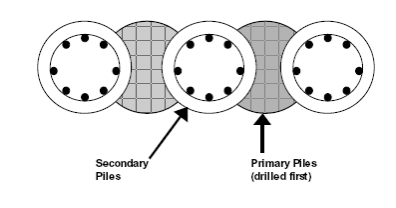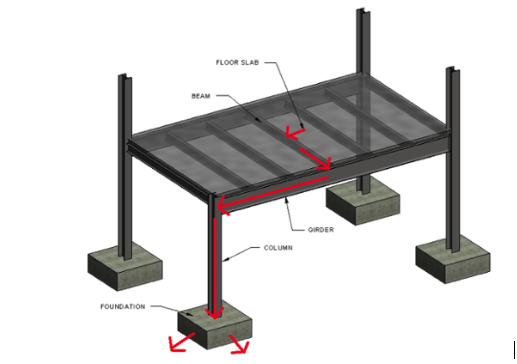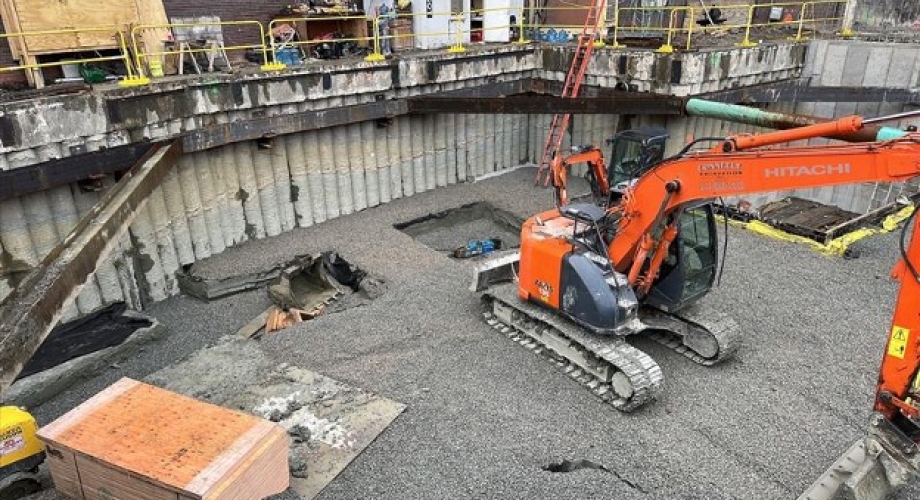Secant piles are most effective for projects in urban environments with limited site space or dense surroundings. When the construction of a new building extends right up to the property line of the site, or there are difficult ground conditions, secant piles offer flexibility in shape and provide both foundation and excavation support. In areas where the excavation support is limited using secant piles eliminates the need for temporary excavation support (i.e. sheet piles, lagging, etc.). Secant Piles can also be considered as an alternative to underpinning a neighboring building.
A unique corner site in Boston’s Kendall Square neighborhood proved ideal for Bala to design a structural solution using secant piles. Since the project site directly abuts an existing high-rise building on 2 sides, utilizing secant piles allowed us to maximize the building area at the basement level and on the floors above.
What Are Secant Piles?
Secant piles are foundation elements that consist of overlapping concrete cylinders drilled into the earth with a capping beam that ties them together at the top. Typically, the diameter of secant piles ranges from 20-24” with 3-4” overlap between the piles; however, they can be up to 48” in diameter when required. Secant piles not only act as vertical bearing supports (i.e., foundations), but also earth retaining systems to support excavation.
There are 3 main components of secant pile construction, primary piles, secondary piles, and capping beams. Each element serves its own purpose in the foundation system, but comes together to give overall foundation support both laterally and vertically.
Primary Piles
Primary piles are used to distribute the lateral load caused by retaining earth to the secondary piles. They are also intended to provide a continuous bearing support wall along the entire foundation and disperse the vertical load similar to a wall distributing load along its height. Typically, these piles have a compressive strength of 2500 pounds-per-square inch (psi).
Secondary Piles
Secondary piles are the main lateral resisting system of the secant pile walls. These piles are reinforced using traditional reinforcement (like a concrete column) or by embedding a steel pile inside them. Depending on the vertical and lateral loads implemented, these steel shapes can either be W-Shapes or HP Shapes. The compressive strength of these piles is typically 4000psi concrete.
Capping Beam
A capping beam is located at the top of the secant pile walls. It serves multiple purposes including tying the walls together at the top of the piles, distributing column loads across multiple secondary piles (similar to pile caps in caisson construction), and giving the secondary piles something to rigidly attach to.

How do Secant Piles Work?
One of the most important aspects of structural engineering is Load Path and understanding how load travels from one instance to its final destination. The image below shows the load path of conventional steel framing.

As mentioned before, secant piles act as both the foundation system (Gravity Load Path) as well as the support of excavation (Lateral Load Path).
Gravity Load Path
The vertical load carrying element, whether it is a column or bearing wall, is anchored to the top of the capping beam. The capping beam then disperses this load out to multiple piles. From there, the load continues to be dispersed along the continuous secant pile wall, similar a bearing wall that disperses load as it travels down. This allows for the foundation system to be designed on a per-linear foot basis.

Lateral Load Path
When excavating into earth, we must address how to resist the soil from collapsing in on itself. This is often referred to as the support of excavation. Soil behaves similar to liquid, and when there is nothing to prevent it from flowing it will do exactly just that. Think of an above ground pool with the walls surrounding the water. What would that water do if the walls were not there? Without supports soil does the same. There are additional loadings that can increase this lateral load which include: surcharge from a street or a neighboring building’s foundation. (Main takeaway: be careful digging deep holes on the beach!)
The primary piles are mainly there to distribute the lateral load to the secondary piles. The main lateral resisting system in the secant pile system are the secondary piles, because they are reinforced to be able to take the moment applied by the soil loads.
How are Secant Piles Constructed?
The first step in secant piles construction is the installation of the primary piles. These typically have a compressive strength of 2500psi because when the secondary (or reinforced) piles are installed, they will be drilled into the primary piles. This creates the 3-4” overlap between the piles and allows the piles to act as a continuous system. The reinforced piles have dowels that tie the members to the cap beam. In instances where the reinforcement is a HP or W-Shape, the steel member will extrude out of the pile and be embedded into the capping beam. The YouTube video below illustrates this process, presented by Piling Contractors YouTube page.
YouTube link: https://www.youtube.com/watch?v=UF9FLUioZv8&t=6s (Reference: Piling Contractors)
Advantages and Disadvantages to Secants Piles
Advantages:
- Flexible alignment during construction
- Acts as the foundation system and excavation support
- Better structural integrity compared to sheet piles
- Can be installed in difficult ground conditions including bedrock
- Less noisy construction
Disadvantages:
- Cost associated – More Concrete and Steel, specialty equipment.
- Waterproofing can be a challenge
- Vibration monitoring can be required
- Vertical tolerances (Typically +/- 0.5% Length of Piles) for deep piles may be difficult to abide by
Design For Secant Piles
There are two overall instances for the design of secant piles: the temporary condition (i.e. support of excavation) and the permanent condition (building’s foundation system). Each instance requires two separate analyses that will ultimately govern the final design of the secant pile wall. The analysis requires extensive coordination between the structural engineer of record, the geotechnical engineer, and the support of excavation engineer.
Typically, there are temporary braces installed as the excavation process is ongoing. Secants can be designed to be pure cantilevers, meaning they do not rely on the structural slabs for bracing in their permanent condition. . However, regardless of whether the secant pile is designed as a true cantilever or a prop cantilever (i.e. relying on the structural slabs for support), the load path ultimately will change due to the discrepancy of the support points.
Conclusion
Secant piles offer many advantages for urban environments with restrictive site conditions. This structural system maximizes the site area, reduces the construction noise for the community and can be used for many different ground conditions. The successful implementation of secant piles relies on the close coordination and collaboration of the engineering teams, the architect, and the construction team. We understand the requirements and ideal conditions for this structural system and look forward to implementing it on future urban projects.


